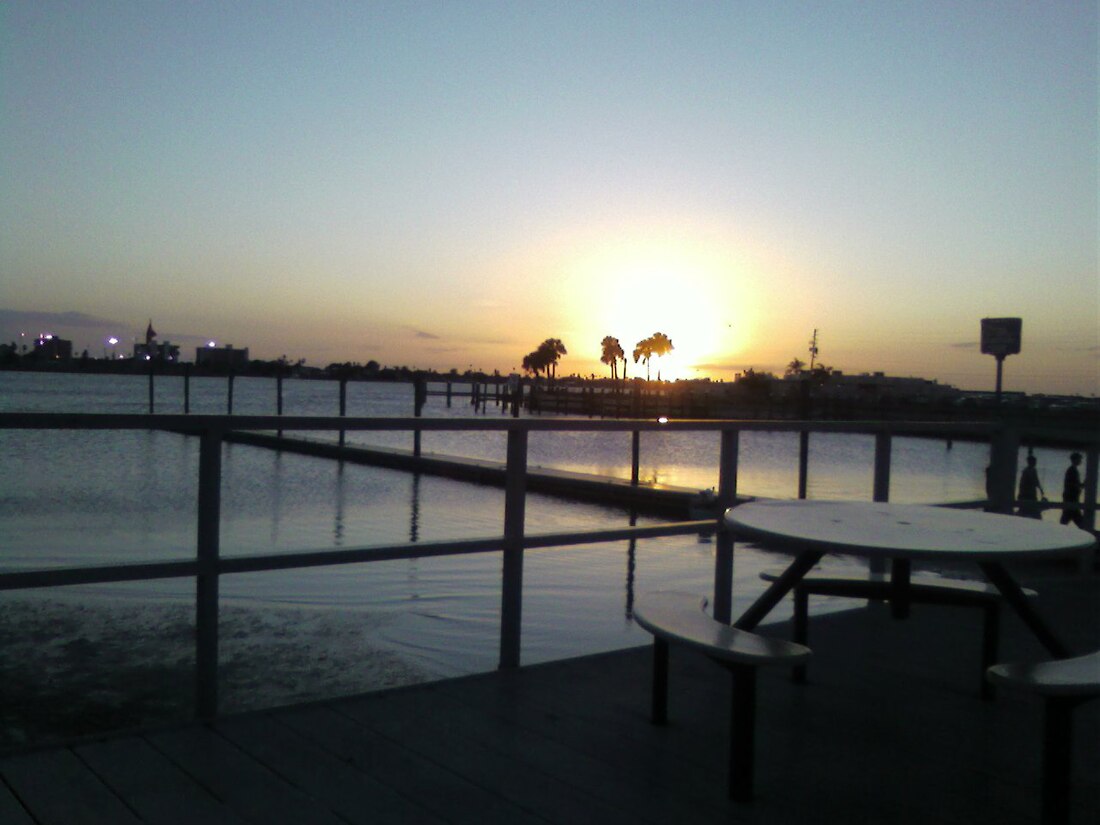Top Qs
Timeline
Chat
Perspective
Madeira Beach, Florida
City in Florida, United States From Wikipedia, the free encyclopedia
Remove ads
Madeira Beach (/məˈdɛərə/ mə-DAIR-ə) is a city in Pinellas County, Florida, United States, bordered on the west by the Gulf of Mexico, and on the east by St. Petersburg. As of the 2020 census, the population was 3,895. The entertainment district of John's Pass is located on the Intracoastal Waterway. The city is often referred to by locals as Mad Beach.[5] It is named after the Portuguese island of Madeira.[6]
Remove ads
Remove ads
History
Summarize
Perspective
Prior to European colonization, the area that makes up what is now Madeira Beach was rarely permanently inhabited. The local Tocobaga chiefdom used the land to harvest seafood, but did not live on the land.
The modern shape of Madeira Beach was formed by a hurricane, the "Gale of '48", carving out the strait now known as John's Pass. The new waterway was named after an early homesteader, John (Juan) Levique.[7]
Several aborted attempts to settle the area occurred in the early 1900s, but it was not until 1926 that a causeway was built between the mainland and Madeira Beach, allowing for the first houses to be constructed in the area. A bridge was built crossing John's Pass a year later. Madeira Beach incorporated as a town in May 1947. The town annexed the nearby municipality of South Madeira in 1951. Significant dredging operations on the intracoastal causeway dramatically expanded the land area of Madeira Beach in the 1950s and 1960s. Additionally, the town annexed some land on mainland Pinellas in 1955 for the construction of a shopping center and a school, now Madeira Beach Fundamental School.[7]
The town saw significant construction in the 1970s and 1980s, including the construction of many beach condos and hotels along the beach. Today, it remains a sleepy beach town, popular as a vacation destination.
Remove ads
Geography
The coordinates for the City of Madeira Beach is located at 27°47′45″N 82°47′26″W.[8]
According to the United States Census Bureau, the city has a total area of 3.3 square miles (8.5 km2), of which 1.0 square mile (2.6 km2) is land, and 2.2 square miles (5.7 km2) (68.50%) are water.[9]
The city is located on a barrier island between the Gulf of Mexico to the southwest, and the Boca Ciega Bay to the northeast. One bridge, the Tom Stuart Causeway, connects Madeira Beach to the mainland, in the unincorporated community of Bay Pines. To the northwest of Madeira Beach is the town of Redington Beach, and to the southeast, across the inlet of John's Pass, is the city of Treasure Island.
Remove ads
Climate
The City of Madeira Beach is in a humid subtropical climate zone with a Köppen Climate Classification of "Cfa" (C = mild temperate, f = fully humid, and a = hot summer).
Demographics
Summarize
Perspective
2010 and 2020 census
As of the 2020 United States census, there were 3,895 people, 2,001 households, and 1,310 families residing in the city.[13]
As of the 2010 United States census, there were 4,263 people, 2,278 households, and 1,100 families residing in the city.[14]
2000 census
At the 2000 census, there were 4,511 people in 2,528 households, including 1,122 families, in the city. The population density was 4,392.0 inhabitants per square mile (1,695.8/km2). There were 3,976 housing units, at an average density of 3,871.1 per square mile (1,494.6/km2). The racial makeup of the city was: 97.05% White, 0.27% African American, 0.31% Native American, 0.58% Asian, 0.04% Pacific Islander, 0.67% from other races, and 1.09% from two or more races. Hispanic or Latino of any race made up 2.37%.[3]
Of the 2,528 households in 2000, 9.1% had children under the age of 18 living with them; 35.6% were married couples living together; 5.6% had a female householder with no husband present; and 55.6% were non-families. 42.4% of households were one person, and 12.2% were one person aged 65 or older. The average household size was 1.78, and the average family size was 2.36.
In 2000, the age distribution was 8.2% under the age of 18; 4.8% from 18 to 24; 29.3% from 25 to 44; 35.7% from 45 to 64; and 22.0% that are 65 or older. The median age was 48 years. For every 100 females, there were 111.3 males. For every 100 females age 18 and over, there were 110.2 males.
In 2000, the median household income was $36,671, and the median family income was $50,833. Males had a median income of $32,353, versus $27,455 for females. The per capita income for the city was $30,097. About 4.1% of families and 9.8% of the population were below the poverty line, including 4.1% of those under age 18, and 12.2% of those age 65 or over.
Remove ads
Points of interest
Chicken Church

Madeira Beach's Church By The Sea is a non-denominational church serving the gulf beaches including Madeira Beach, Treasure Island, Redington, St. Pete Beach, as well as the cities of Seminole and St. Petersburg.[15][16] Construction for the church lasted from 1944 to 1946.[17][18]
The church has become a tourist attraction because its tower resembles a chicken; it is known colloquially as the "Chicken Church".[19][20]
John's Pass Marina

On September 24, 1848, a strong hurricane struck the West Coast of Florida. It separated the barrier island on the coast and created a waterway known today as John's Pass. John Levique, along with Joseph Silva, was the one who discovered it and named it after himself, and it is now a federally owned canal.
In 2022, the Governor of Florida, Ron DeSantis, included in the budget $1,500,000 to dredge John's Pass.[21][22]
Remove ads
See also
References
External links
Wikiwand - on
Seamless Wikipedia browsing. On steroids.
Remove ads


